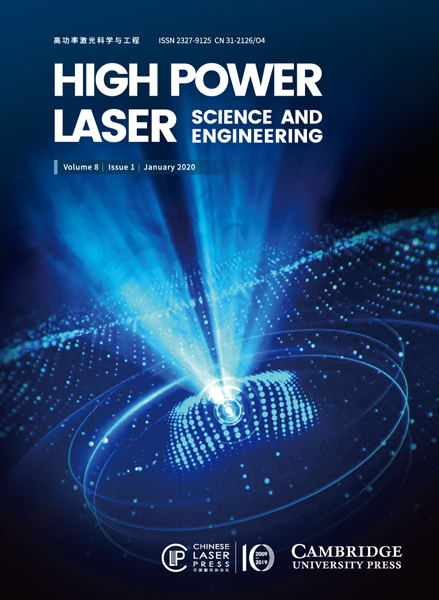2017, 5(4) Column
High Power Laser Science and Engineering 第5卷 第4期
Improvements in long-term output energy performance of Nd:glass regenerative amplifiers Download:723次
Download:723次
 Download:723次
Download:723次Optical damages, which severely degrade the output energy performance of Nd:glass regenerative amplifiers, are discussed in detail in this paper. By a series of experiments, it has been confirmed that these damages result from laser-induced contamination. Based on this work, several improvements are made to boost output energy performance of the regenerative amplifier. The output energy of the regenerative amplifier after improvements declines 4% after 1000 h of operation, much less than it used to, 60% after 560 h of operation.
diode-pumped solid-state laser and application high-power laser high-power laser related laser components laser amplifiers laser induced damage preamplifiers REACH compliant epoxides used in the synthesis of Fe(III)-based aerogel monoliths for target fabrication Download:579次
Download:579次
 Download:579次
Download:579次Aerogel materials manufactured from metal oxides have been used as components in numerous high-energy density physics targets. These aerogels have been identified to be used as a future target material in the AWE fielded campaigns at the US National Ignition Facility. A wide variety of metal oxide aerogels are required for future campaigns and therefore a versatile manufacturing route is sought; as such, an epoxide-assisted sol–gel route was investigated. Under the European Union Registration, Evaluation, Authorization and Restriction of Chemicals legislation, the most commonly used epoxide, propylene oxide, is recognized as a substance of very high concern (SVHC). This work sought to investigate suitable alternative epoxides for use in target manufacture. The outcome was the identification of synthesis routes for stable metal oxide aerogel monoliths using epoxides not subject to the above restrictions.
aerogel epoxide metal oxide sol–gel SVHC With European Laser Facilities such as the Extreme Light Infrastructure (ELI) and the Helmholtz International Beamline for Extreme Fields (HIBEF) scheduled to come online within the next couple of years, General Atomics, as a major supplier of targets and target components for the High Energy Density Physics community in the United States, is gearing up to meet their demand for large numbers of low cost targets. Using the production of a subassembly for the National Ignition Facility’s fusion targets as an example, we demonstrate that through automation of assembly tasks, the design of targets and their experimental setup can be fairly complex while keeping the assembly time and cost as a minimum. A six-axis Mitsubishi robot is used in combination with vision feedback and a force–torque sensor to assemble target subassemblies of different scales and designs with minimal change of tooling, allowing for design flexibility and short assembly setup times. Implementing automated measurement routines on a Nikon NEXIV microscope further reduces the effort required for target metrology, while electronic data collection and transfer complete a streamlined target production operation that can be adapted to a large variety of target designs.
assembly automation hohlraum robotics target We experimentally investigate the generation of above-threshold harmonics completely from argon atoms on an excited state using mid-infrared femtosecond laser pulses. The highly nonlinear dependences of the observed signal on the pulse energy and polarization of the probe laser pulses indicate its nonperturbative characteristic.
above-threshold harmonics excited state mid-infrared femtosecond laser A modeling method to extract the mechanical properties of ultra-thin films (10–100 nm thick) from experimental data generated by indentation of freestanding circular films using a spherical indenter is presented. The relationship between the mechanical properties of the film and experimental parameters including load, and deflection are discussed in the context of a constitutive material model, test variables, and analytical approaches. Elastic and plastic regimes are identified by comparison of finite element simulation and experimental data.
indentation optimization ultra-thin films Laser target components consist of multicomponent porous and nonporous materials that are adhesively bonded together. In order to assess the extent and quantity of adhesive wicking into porous foam, micro X-ray computed tomography (CT) and image processing software have been utilized. Two different laser target configurations have been assessed in situ and volume rendered images of the distribution and quantities of adhesive have been determined for each.
adhesive wicking carbon aerogel critical point drying image processing phase contrast plasma physics experiments porous foam volume rendering X-ray CT Preparation of ultra-broadband antireflective coatings for amplifier blast shields by a sol–gel method Download:542次
Download:542次
 Download:542次
Download:542次A type of $\unicode[STIX]{x1D706}/4$ –$\unicode[STIX]{x1D706}/4$ ultra-broadband antireflective coating has been developed using modified low refractive silica and high refractive silica layers by a sol–gel dip coating method for amplifier blast shields of the Shen Guang II high power laser facility (SG-II facility). Deposition of the first layer (high refractive index silica) involves baking at $200\,^{\circ }\text{C}$ in the post-treatment step. The second layer (low refractive index, $n=1.20$ ) uses low refractive index silica sol modified by acid catalysis. Thermal baking at temperatures no less than $500\,^{\circ }\text{C}$ for 60 min offers chemical stability, ethanol scratch resistance, and resistance to washing with water. The average residual reflection of dual-side-coated fused silica glass was less than 1% in the spectral range from 450 to 950 nm. Transmission gain has been evaluated by taking into account angular light, and the results show that the transmission gain increases with increasing light incidence. Even at $60^{\circ }$ , the transmission spectrum of the broadband antireflective coating effectively covered the main absorption peak of Nd:glass.
amplifier antireflective coating blast shields sol–gel ultra-broadband In this manuscript, we demonstrate high-power, narrow-linewidth linearly polarized fiber laser with excellent beam quality through compact one-stage amplification scheme. By employing a single-mode–multimode–single-mode structure seed laser, a linearly polarized Yb-doped fiber laser with narrow linewidth and high output power is achieved. This laser, when used as a master oscillator, can be capable of suppressing the ASE in the process of power amplification. Thus, only one-stage amplification structure is used to scale up the laser power, and linearly polarized output with a polarization extinction ration of 14 dB, a narrow linewidth of 0.3 nm and an output power of 1018 W are achieved. Moreover, due to the good beam quality of seed laser and the well-designed amplifier stage, the beam quality of the output laser is near-diffraction-limited with $M_{x}^{2}\sim 1.18$ and $M_{y}^{2}\sim 1.24$ at the maximum power, and without mode instability occurring.
fiber amplifier fiber Bragg grating linearly polarization narrow linewidth Stimulated Brillouin scattering (SBS) effect is currently the major limitation for the power scaling of single-frequency/narrow linewidth fiber laser systems. A single-mode linearly polarized all-fiber amplifier system is set up to investigate SBS effect in triple-frequency high-power amplifiers. With this amplifier, up to 302 W output power with 83% slope efficiency is achieved and the SBS threshold is scaled up to 12 dB. To the best of our knowledge, this is the highest output power of multifrequency laser from a single-mode polarization maintaining fiber. Good spectral properties and high brightness make this laser source available for the application of second harmonic generation, coherent beam combining.
fiber laser and applications nonlinear optics 动态信息
动态信息 丨 2023-06-21
HPL Highlight (Vol. 11, e40): NIF仍然是全球唯一一个能够进行ICF点火实验的装置动态信息 丨 2023-06-21
HPL Highlight (Vol. 11, e9): 变分神经网络预测激光尾波场加速电子能谱动态信息 丨 2023-06-21
HPL Highlight (Vol. 11, e7): 目标探测网络加入,激光等离子体加速器实现实时诊断动态信息 丨 2023-06-21
HPL Highlight (Vol. 11, e5): 910 nm波段超宽带种子源,向100 PW超强超短激光进发动态信息 丨 2023-06-21
HPL Highlight (Vol. 11, e4): 100 PW单束压缩!多步压缩器进阶双光栅激光评论微信公众号

点击菜单“联系编辑”即可添加期刊编辑为好友啦












